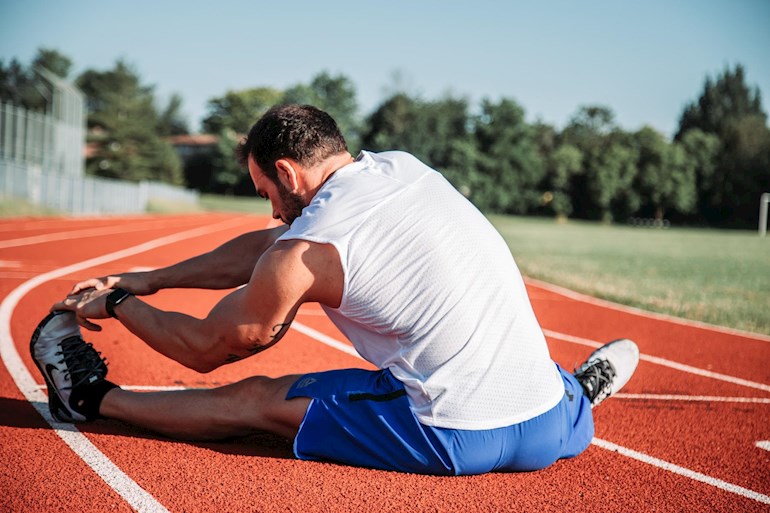Photo by Alora Griffiths on Unsplash
The question in the title often gets asked by new C25k graduates, as if by completing the programme, they have miraculously developed bodies that are immune to injury and they no longer have to stick with the annoying warm up and cool down procedures. Elite athletes always extensively warm up and cool down their exquisitely honed bodies……….us mere mortals need to follow their lead.
WHY WARM UP?
When we start a workout with a brisk walk, we are gently increasing our body temperature and heart rate, dilating blood vessels and improving our circulation throughout the body but especially to the muscles, so they are prepared for work and are less prone to injury. Warm muscles become more pliable and flexible and are therefore less likely to become damaged once you start working them hard. As we age, heart rate is decreased, blood flow may be restricted and warm up needs to be taken even more seriously.
If you Google running warm up exercises, you will find plenty of articles and videos to inform you.
The five minute brisk walk advocated for the C25k programme is perfectly adequate for most people, most of the time. However, if the weather is particularly cold, or you have muscle groups that tend to be tight even after a warm up walk, or if you are about to attempt to break your 5k pb, then it is definitely worth doing more.
I am not going to list routines here, because it is far better that you get used to doing your own research, but the basic idea is to gently increase the mobility of joints by increasing the intensity. In the guide to the C25k plan there is a link to a set of dynamic stretches/exercises recommended by the NHS nhs.uk/live-well/exercise/h... which many swear by.
I will admit that I have only ever done dynamic warm up exercises when the weather is really cold or before a parkrun, or other pb attempt, where I have also ended up jogging very gently for the best part of ten minutes in an attempt to overcome the Toxic Ten which plagues most runners at the start of a run. This enables you to push much harder at the beginning of a run without suffering oxygen deficiency. This post explains the Toxic Ten healthunlocked.com/couchto5... Otherwise, start your run nice and gently, then slowly build up to your target pace.
Many new runners make the mistake of doing static stretches prior to a run, which is not recommended, as these can reduce the power of muscles and potentially lead to injury. So stick to your brisk walk and other pre run dynamic stretches routines recommended for runners.
The following may be helpful to start you on your research.
youtube.com/watch?v=sfF4f-Q...
runnersworld.com/beginner/a...
WHY COOL DOWN?
Cool down, or warm down as it is sometimes referred to, is an essential part of bringing your body back to a resting state, allowing temperature and heart rate to gradually decrease and return to normal. After a C25k workout, which should never be at a high intensity, a brisk 5 minute walk is perfectly adequate. If you have just done a hard run, then it is recommended to follow that with a few minutes of gentle jog, before reducing to a walk, again for a few minutes.
If you suddenly stop running, without a cool down walk, then you increase the risk of blood pooling in your legs, which can cause varicose veins, low blood pressure, light headedness and even faints. This is more likely to happen as we age, as the elasticity of veins reduces. It is also crucial for those suffering from, or at risk of, cardiovascular disease.
For me, an absolutely essential part of my cool down regime is to do static stretches nhs.uk/live-well/exercise/r... When you work your body hard, muscles can contract and even knot and this can restrict blood flow. Recovery and repair of muscles is dependent on good blood flow, so pulling out the constrictions immediately after your cool down walk, while muscles are still warm and supple, will improve repair and strengthening and avoid carrying muscular tensions into the next run. I always hold my static stretches for 30 seconds and the pull needs to be on the verge of discomfort………..a quick flex does virtually nothing.
Post run it is always important to replenish your fluids, which can be done as you stretch and reflect on your glorious workout achievements.
You may see runners run from their doorstep………...but they may have warmed up indoors.
You may see runners complete a 5k run then get into their cars and drive off………….you don’t know how much of the year they spend injured.
I have never heard of anyone getting injured by doing a longer warm up or cool down.
You may know runners who say they never stretch and they have never been injured……….I would rather follow the precautionary regimes employed by elite athletes, so that I can keep running and keep smiling.
There are more FAQ posts giving general information here healthunlocked.com/couchto5...
